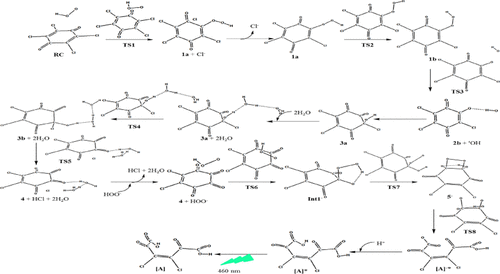当前位置:
X-MOL 学术
›
J. Org. Chem.
›
论文详情
Our official English website, www.x-mol.net, welcomes your
feedback! (Note: you will need to create a separate account there.)
Theoretical Study on Chemiluminescence of H2O2-dependent Tetrachloro-1,4-benzoquinone.
The Journal of Organic Chemistry ( IF 3.3 ) Pub Date : 2020-06-16 , DOI: 10.1021/acs.joc.0c00955 Yi-Qi Tang 1 , Ya-Jun Liu 1
The Journal of Organic Chemistry ( IF 3.3 ) Pub Date : 2020-06-16 , DOI: 10.1021/acs.joc.0c00955 Yi-Qi Tang 1 , Ya-Jun Liu 1
Affiliation

|
Compared with O2-dependent chemiluminescence (CL) and bioluminescence (BL), H2O2-dependent ones are far from being completely understood. A two-step mechanism for H2O2-dependent CL production from tetrachloro-1,4-benzoquinone (TCBQ) was proposed based on experimental evidence of detecting the formation of several intermediates and products. This mechanism is not yet supported by theoretical evidence, and its details remain unknown. In the present paper, we performed multireference and (time-dependent) density functional theory calculations on the complete reaction process of TCBQ with H2O2 to produce CL. The calculations reproduced the experimentally observed two-step CL. Although the reactants are different, the first and second CLs follow very similar reaction processes and mechanisms. First, an anionic dioxetane is formed via five sequential reactions. The intrinsically produced •OH is crucial for forming dioxetane. Subsequently, the anionic dioxetane decomposes to produce an anionic excited-state (S1) product. A conical interaction of the ground and the S1-state potential energy surfaces is responsible for producing the S1-state product. Finally, the S1-state anionic product changes to its neutral form, and the latter emits light as an actual light emitter. This mechanism could be extended to luminescent systems of all H2O2-dependent tetrahalogenated quinoids, including acorn worms, because TCBQ/H2O2 is a typical representative of these luminescent systems.
中文翻译:

H2O2依赖性四氯-1,4-苯醌化学发光的理论研究。
与O 2依赖的化学发光(CL)和生物发光(BL)相比,H 2 O 2依赖的化学发光远未完全被理解。基于检测到几种中间体和产物形成的实验证据,提出了由四氯-1,4-苯醌(TCBQ)产生H 2 O 2依赖的CL的两步机理。该机制尚未得到理论证据的支持,其细节仍然未知。在本文中,我们对TCBQ与H 2 O 2的完整反应过程进行了多参考和(随时间变化)密度泛函理论计算。产生CL。计算结果重现了实验观察到的两步CL。尽管反应物不同,但是第一和第二CL遵循非常相似的反应过程和机理。首先,通过五个顺序反应形成阴离子二氧杂环丁烷。内在产生的• OH对于形成二氧杂环丁烷至关重要。随后,阴离子二氧杂环丁烷分解产生阴离子激发态(S 1)产物。地面和S 1状态势能面的圆锥形相互作用是产生S 1状态产物的原因。最后,S 1态阴离子产物变为中性形式,后者作为实际的发光体发光。由于TCBQ / H 2 O 2是这些发光系统的典型代表,因此该机制可以扩展到所有H 2 O 2依赖性四卤代醌类的发光系统,包括橡子蠕虫。
更新日期:2020-07-17
中文翻译:

H2O2依赖性四氯-1,4-苯醌化学发光的理论研究。
与O 2依赖的化学发光(CL)和生物发光(BL)相比,H 2 O 2依赖的化学发光远未完全被理解。基于检测到几种中间体和产物形成的实验证据,提出了由四氯-1,4-苯醌(TCBQ)产生H 2 O 2依赖的CL的两步机理。该机制尚未得到理论证据的支持,其细节仍然未知。在本文中,我们对TCBQ与H 2 O 2的完整反应过程进行了多参考和(随时间变化)密度泛函理论计算。产生CL。计算结果重现了实验观察到的两步CL。尽管反应物不同,但是第一和第二CL遵循非常相似的反应过程和机理。首先,通过五个顺序反应形成阴离子二氧杂环丁烷。内在产生的• OH对于形成二氧杂环丁烷至关重要。随后,阴离子二氧杂环丁烷分解产生阴离子激发态(S 1)产物。地面和S 1状态势能面的圆锥形相互作用是产生S 1状态产物的原因。最后,S 1态阴离子产物变为中性形式,后者作为实际的发光体发光。由于TCBQ / H 2 O 2是这些发光系统的典型代表,因此该机制可以扩展到所有H 2 O 2依赖性四卤代醌类的发光系统,包括橡子蠕虫。











































 京公网安备 11010802027423号
京公网安备 11010802027423号